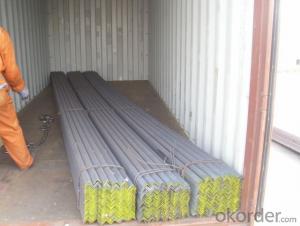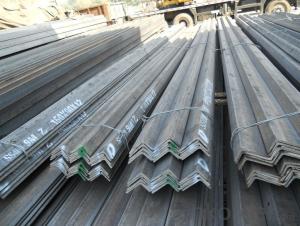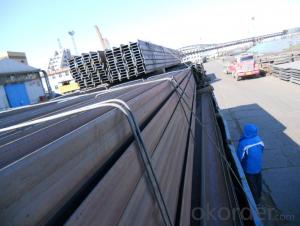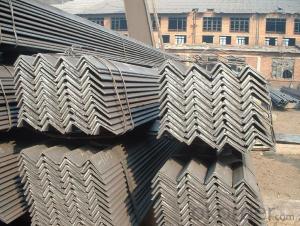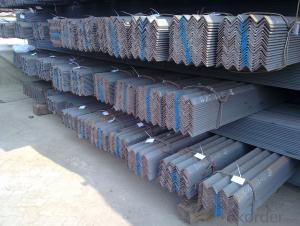High Quality Cold Rolled Steel Unequal Angle for Construction
- Loading Port:
- China main port
- Payment Terms:
- TT OR LC
- Min Order Qty:
- 25000 m.t.
- Supply Capability:
- 2000000 m.t./month
OKorder Service Pledge
OKorder Financial Service
You Might Also Like
Specification
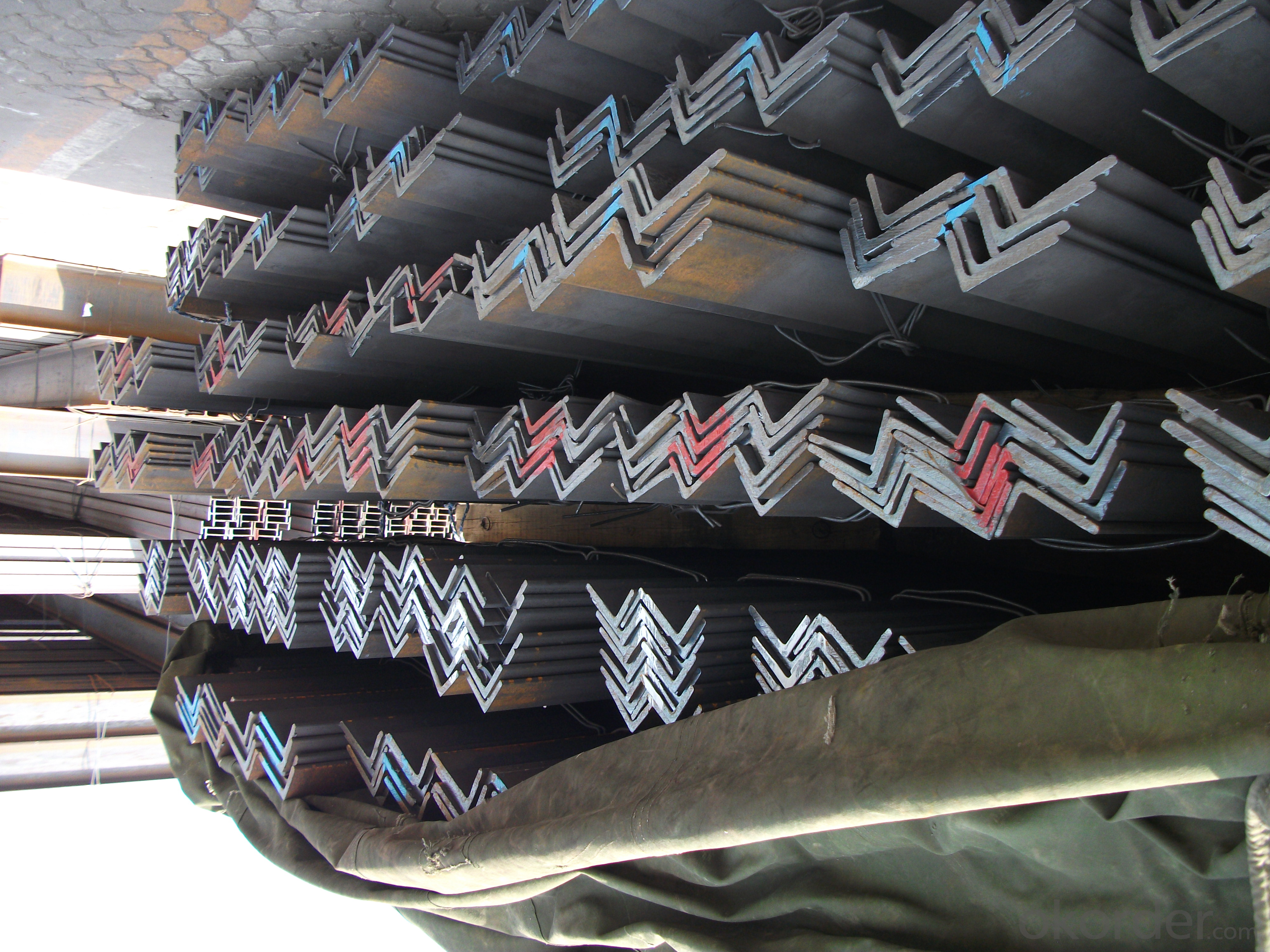 Product Description:
Product Description:
OKorder is offering High Quality Cold Rolled Steel Unequal Angle for Construction at great prices with worldwide shipping. Our supplier is a world-class manufacturer of steel, with our products utilized the world over. OKorder annually supplies products to European, North American and Asian markets. We provide quotations within 24 hours of receiving an inquiry and guarantee competitive prices.
Product Applications:
High Quality Cold Rolled Steel Unequal Angle for Construction are ideal for structural applications and are widely used in the construction of buildings and bridges, and the manufacturing, petrochemical, and transportation industries.
Product Advantages:
OKorder's High Quality Cold Rolled Steel Unequal Angle for Construction are durable, strong, and resist corrosion. They are newly produeced by good materiales.
Main Product Features:
· Premium quality
· Prompt delivery & seaworthy packing (30 days after receiving deposit)
· Corrosion resistance
· Can be recycled and reused
· Mill test certification
· Professional Service
· Competitive pricing
Product Specifications:
Specifications of High Quality Cold Rolled Steel Unequal Angle for Construction
1. Invoicing on theoretical weight or actual weight as customer request
2. Length: 6m, 9m, 12m as following table
3. Sizes
Sizes: 25mm-250mm | ||
a*t | ||
25*2.5-4.0 | 70*6.0-9.0 | 130*9.0-15 |
30*2.5-6.6 | 75*6.0-9.0 | 140*10-14 |
36*3.0-5.0 | 80*5.0-10 | 150*10-20 |
38*2.3-6.0 | 90*7.0-10 | 160*10-16 |
40*3.0-5.0 | 100*6.0-12 | 175*12-15 |
45*4.0-6.0 | 110*8.0-10 | 180*12-18 |
50*4.0-6.0 | 120*6.0-15 | 200*14-25 |
60*4.0-8.0 | 125*8.0-14 | 250*25 |
5. Payment terms:
1).100% irrevocable L/C at sight.
2).30% T/T prepaid and the balance against the copy of B/L.
3).30% T/T prepaid and the balance against L/C
6.Material details:
Alloy No | Grade | Element (%) | |||||
C | Mn | S | P | Si | |||
Q235 | B | 0.12—0.20 | 0.3—0.7 | ≤0.045 | ≤0.045 | ≤0.3 | |
Alloy No | Grade | Yielding strength point( Mpa) | |||||
Thickness (mm) | |||||||
≤16 | >16--40 | >40--60 | >60--100 | ||||
≥ | |||||||
Q235 | B | 235 | 225 | 215 | 205 | ||
Alloy No | Grade | Tensile strength (Mpa) | Elongation after fracture (%) | ||||
Thickness (mm) | |||||||
≤16 | >16--40 | >40--60 | >60--100 | ||||
≥ | |||||||
Q235 | B | 375--500 | 26 | 25 | 24 | 23 | |
Usage & Applications of High Quality Hot Rolled Steel Unequal Angle Equal Angle for Construction
According to the needs of different structures, Angle can compose to different force support component, and also can be the connections between components. It is widely used in various building structures and engineering structures such as roof beams, bridges, transmission towers, hoisting machinery and transport machinery, ships, industrial furnaces, reaction tower, container frame and warehouse etc.
Packaging & Delivery of High Quality Cold Rolled Steel Unequal Angle for Construction
1. Packing: it is nude packed in bundles by steel wire rod
2. Bundle weight: not more than 3.5MT for bulk vessel; less than 3 MT for container load
3. Marks:
Color marking: There will be color marking on both end of the bundle for the cargo delivered by bulk vessel. That makes it easily to distinguish at the destination port.
Tag mark: there will be tag mark tied up on the bundles. The information usually including supplier logo and name, product name, made in China, shipping marks and other information request by the customer.
If loading by container the marking is not needed, but we will prepare it as customer request.
Production flow ofHigh Quality Cold Rolled Steel Unequal Angle for Construction
Material prepare (billet) —heat up—rough rolling—precision rolling—cooling—packing—storage and transportation
FAQ:
Q1: Why buy Materials & Equipment from OKorder.com?
A1: All products offered byOKorder.com are carefully selected from China's most reliable manufacturing enterprises. Through its ISO certifications, OKorder.com adheres to the highest standards and a commitment to supply chain safety and customer satisfaction.
Q2: How do we guarantee the quality of our products?
A2: We have established an advanced quality management system which conducts strict quality tests at every step, from raw materials to the final product. At the same time, we provide extensive follow-up service assurances as required.
Q3: How soon can we receive the product after purchase?
A3: Within three days of placing an order, we will begin production. The specific shipping date is dependent upon international and government factors, but is typically 7 to 10 workdays.
Images:
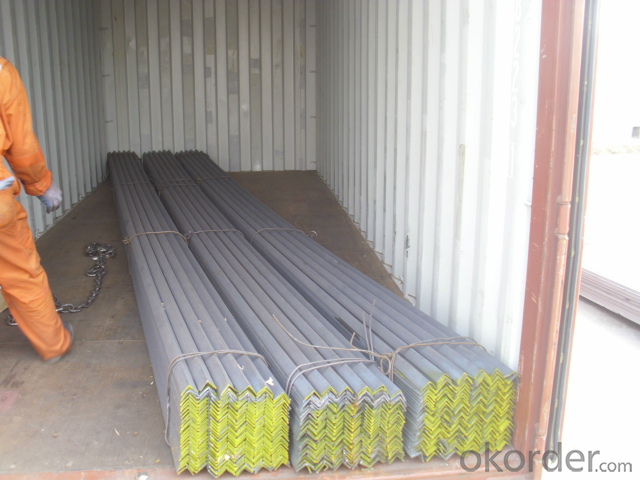

- Q: Can steel angles be used in the construction of industrial platforms?
- Yes, steel angles can be used in the construction of industrial platforms. Steel angles provide strength, stability, and durability, making them suitable for supporting heavy loads and creating a sturdy platform structure.
- Q: What are the different methods of surface finishing for steel angles?
- Steel angles can be finished using various methods, each with its own advantages and considerations. Painting, galvanizing, powder coating, and shot blasting are the most commonly used methods. When it comes to surface finishing steel angles, painting is a popular choice. It not only protects against corrosion but also adds an appealing look. Typically, the angle is cleaned and primed before multiple coats of paint are applied. This method allows for a wide range of colors and easy touch-ups in case of damage. Galvanizing, on the other hand, involves coating the steel angle with zinc to safeguard it from corrosion. This method is particularly effective in harsh environments where moisture or chemicals may be present. The most common technique is hot-dip galvanizing, wherein the angle is immersed in molten zinc. This creates a durable finish that requires minimal maintenance. Another widely used method is powder coating, which entails applying a dry powder to the angle and then curing it with heat. This forms a protective layer that offers excellent durability and resistance to corrosion, chemicals, and UV rays. Powder coating also provides a smooth and consistent finish, with a wide array of color options. For a mechanical surface finishing approach, shot blasting is employed. This method involves blasting the steel angle with high-speed abrasive particles to remove rust, mill scale, or other contaminants. It results in a clean and smooth finish while creating a rough texture that enhances paint adhesion. Shot blasting is often used as a pre-treatment before painting or powder coating. When selecting a surface finishing method for steel angles, it is crucial to consider the specific requirements of their application. Factors such as the environment, expected lifespan, aesthetic preferences, and budget should all be taken into account. Seeking guidance from professionals or the steel manufacturer can help determine the most suitable surface finishing method for steel angles in a given situation.
- Q: What are the different types of steel angles?
- A variety of steel angles exist, each serving specific purposes and applications. Here are some common types: 1. Equal angle: Utilized for structural support, bracing, and framing in construction, this angle boasts equal sides. 2. Unequal angle: Also known as L-shaped or unequal leg angle, it features unequal sides, with one side longer than the other. It finds use in building construction for creating corners, edges, and supports. 3. Stainless steel angle: Crafted from stainless steel, this angle offers exceptional resistance to corrosion. It is commonly employed in environments exposed to moisture or chemicals, such as marine settings or food processing facilities. 4. Galvanized angle: These steel angles are coated with a layer of zinc to safeguard against rust and corrosion. They are frequently utilized in outdoor and industrial settings where durability is crucial. 5. Slotted angle: Equipped with holes or slots along its length, this steel angle facilitates easy attachment and adjustment of components. It is commonly found in shelving systems, storage racks, and DIY projects. 6. Rolled steel angle: Manufactured by rolling steel into a specific shape, it results in a smooth and uniform surface. Rolled steel angles are often employed in manufacturing, machinery, and structural applications. 7. Structural angle: Designed to bear heavy loads and provide structural support, these steel angles are prevalent in building frames, bridges, and other infrastructure projects. These examples represent only a fraction of the diverse range of steel angles available. The selection of the appropriate angle depends on various project requirements, such as load capacity, corrosion resistance, and aesthetic considerations. Seeking advice from professionals or structural engineers can aid in determining the most suitable type of steel angle for a specific application.
- Q: Can steel angles be used for shelving and storage racks?
- Indeed, shelving and storage racks can utilize steel angles. Given their robustness and endurance, steel angles are widely employed in construction and engineering. They offer exceptional structural reinforcement and are capable of withstanding substantial loads, making them a perfect fit for shelving and storage racks. By virtue of their easy fabrication and weldability, steel angles can be effortlessly joined together to create desired designs for shelving or storage racks. Moreover, they come in various dimensions and thicknesses, allowing for customization to meet specific storage requirements. Furthermore, steel angles exhibit resistance against corrosion, making them highly advantageous in environments where moisture or chemicals are prevalent. All in all, steel angles are a reliable and versatile option when it comes to shelving and storage racks.
- Q: Are there any specific design considerations when using steel angles?
- There are several important factors to consider when using steel angles in design. Firstly, it is crucial to assess the load-bearing capacity of the steel angles. These angles are often used in structural applications where they must bear heavy loads. Therefore, it is vital to determine the required strength and stiffness of the angles based on the anticipated loads and design requirements. Secondly, it is necessary to carefully design the connections between the steel angles and other structural elements. These connections must be strong and secure. Various methods, such as bolting, welding, or using additional plates or brackets, can be employed to ensure the stability and integrity of the connections. In addition, the stability of the steel angles themselves must be taken into account. Long and slender steel angles can be susceptible to lateral-torsional buckling when subjected to bending loads. Therefore, appropriate measures, such as bracing or increasing the section modulus, should be implemented to enhance the angles' stability. Furthermore, steel angles may be prone to corrosion, particularly in outdoor or corrosive environments. To prevent or minimize corrosion, adequate protective coatings or treatments should be applied. This will ensure the long-term durability and performance of the angles. Lastly, when using steel angles in architectural or design applications, aesthetic considerations may also be important. The appearance of the angles, including the surface finish or color, should be taken into account to achieve the desired visual effect. To summarize, the load-bearing capacity, connection details, stability, corrosion protection, and aesthetic aspects are all crucial design considerations when working with steel angles. These factors are essential for ensuring the structural integrity, durability, and overall performance of steel angle applications.
- Q: What are the different grades of steel used for manufacturing steel angles?
- Manufacturing steel angles involves the use of various grades of steel. These grades include: 1. Mild Steel: This is the most frequently utilized grade for producing steel angles. It boasts a low carbon content and is reasonably priced. Mild steel angles are suitable for a wide range of applications and possess excellent weldability and formability. 2. High-strength low-alloy (HSLA) steel: This grade incorporates small quantities of alloying elements such as copper, vanadium, or niobium, which augment its strength and toughness. HSLA steel angles are commonly employed in structural applications that demand high strength and durability. 3. Stainless Steel: Stainless steel angles are crafted from alloys that contain a significant chromium content, offering outstanding resistance to corrosion. These angles find common usage in environments where corrosion poses a concern, such as coastal areas or chemical plants. 4. Carbon Steel: Carbon steel angles are comprised of a combination of iron and carbon, with carbon content typically ranging from 0.05% to 2.1%. The higher the carbon content, the stronger and harder the steel becomes. Carbon steel angles are frequently employed in construction and machinery manufacturing. 5. Alloy Steel: Alloy steel angles are created by introducing various alloying elements like manganese, nickel, chromium, or molybdenum into carbon steel. These additions enhance the strength, hardness, and resistance to wear and corrosion of the steel. Alloy steel angles find common usage in heavy-duty applications like mining equipment or industrial machinery. The selection of steel grade for manufacturing steel angles depends on the specific requirements of the application, including desired strength, durability, corrosion resistance, and cost considerations.
- Q: Can steel angles be used for machine frames?
- Yes, steel angles can be used for machine frames. Steel angles are commonly used in construction and engineering applications due to their strength, versatility, and cost-effectiveness. When used in machine frames, steel angles provide structural support and stability. They can be easily welded or bolted together to create a rigid frame structure that can withstand heavy loads and vibrations. The angular shape of steel angles also allows for easy attachment of other components or accessories. Overall, steel angles are a popular choice for machine frames due to their durability and suitability for various industrial applications.
- Q: How do steel angles perform in terms of electromagnetic shielding?
- Steel angles have a reputation for being highly effective in terms of electromagnetic shielding. This is mainly because of their exceptional electrical conductivity and magnetic permeability. These particular qualities enable steel angles to efficiently redirect or absorb electromagnetic waves, resulting in a reduced impact on adjacent electronic devices or sensitive equipment. The shape and geometry of steel angles also play a role in their shielding capabilities, as they can be strategically positioned to create barriers or enclosures that obstruct or redirect electromagnetic fields. Additionally, the thickness or gauge of the steel angle can further amplify its shielding performance. In general, steel angles find widespread use in a variety of applications where minimizing or controlling electromagnetic interference is crucial, such as in the construction, telecommunications, electronics, and automotive industries.
- Q: Are steel angles suitable for manufacturing support brackets for conduits?
- Yes, steel angles are commonly used for manufacturing support brackets for conduits due to their strength, durability, and ability to provide structural support.
- Q: Can steel angles be used in shelving systems?
- Yes, steel angles can be used in shelving systems. Steel angles provide excellent structural support and stability, making them a popular choice for shelving units. They can be easily attached to walls or used as vertical supports, allowing for the customization of shelving layouts. Additionally, steel angles are durable and capable of holding heavy loads, making them suitable for various storage needs.
Send your message to us
High Quality Cold Rolled Steel Unequal Angle for Construction
- Loading Port:
- China main port
- Payment Terms:
- TT OR LC
- Min Order Qty:
- 25000 m.t.
- Supply Capability:
- 2000000 m.t./month
OKorder Service Pledge
OKorder Financial Service
Similar products
Hot products
Hot Searches
Related keywords
